Introduction
Studies have shown that biological material can only last undegraded for a few thousand years, and then, only under the most ideal conditions.[1]
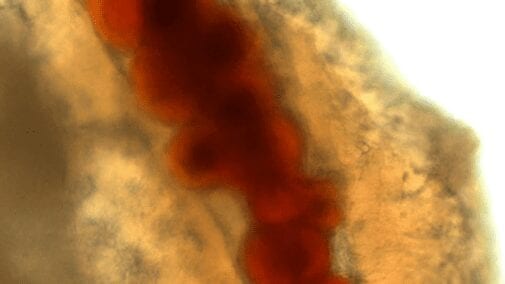 Organic remains have been found in an increasing number of animals which are meant to be millions of years old. In 1997 Dr Mary Schweitzer of Montana State University Laboratory shocked the scientific community when she found soft tissue, including blood vessels containing red blood cells, in a “68-million-year-old” Tyrannosaurus rex.[2] See images right.
Organic remains have been found in an increasing number of animals which are meant to be millions of years old. In 1997 Dr Mary Schweitzer of Montana State University Laboratory shocked the scientific community when she found soft tissue, including blood vessels containing red blood cells, in a “68-million-year-old” Tyrannosaurus rex.[2] See images right.
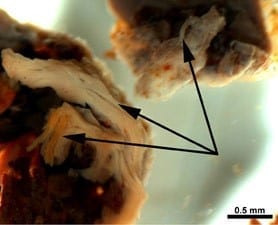 Twelve years later she announced that she had found similar organic remains in a duckbilled dinosaur.[3] New Scientist reported that Maria McNamara of University College, Dublin had found well preserved bone marrow in half of the “10 Million-year-old” fossil frogs she was investigating.[4] Australian researchers were astonished to recover well-preserved blood vessels, nerve cells and muscle tissue from an armored-plated fish meant to be 380 million years old.[5] Further, New Scientist reported that:
Twelve years later she announced that she had found similar organic remains in a duckbilled dinosaur.[3] New Scientist reported that Maria McNamara of University College, Dublin had found well preserved bone marrow in half of the “10 Million-year-old” fossil frogs she was investigating.[4] Australian researchers were astonished to recover well-preserved blood vessels, nerve cells and muscle tissue from an armored-plated fish meant to be 380 million years old.[5] Further, New Scientist reported that:
The first fossil brain ever discovered is that of a 300-million-year-old fish. Alan Pradel of the French 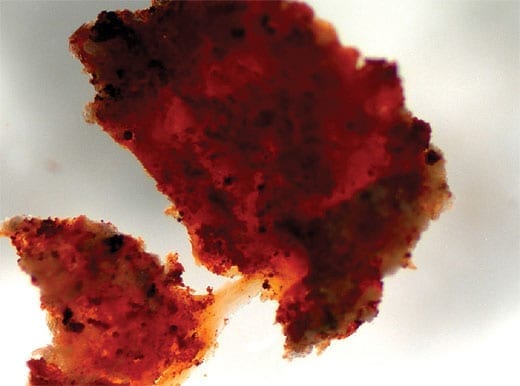 Natural History Museum and his team took X-rays of four iniopterygian fish fossils from the Carboniferous period—Pradel was stunned to realize that the faint object ‘like a ghost’ inside one skull meant that the brain itself had been preserved.[6]
Natural History Museum and his team took X-rays of four iniopterygian fish fossils from the Carboniferous period—Pradel was stunned to realize that the faint object ‘like a ghost’ inside one skull meant that the brain itself had been preserved.[6]
Bacteria alive and well after “millions” of years
It requires an even greater step of faith to believe that complete entities, such as bacteria, can be isolated after millions of years with all of their biochemical and biological parts functioning well, such that they can resume living. But this is what is being claimed.
- Bacteria frozen in Antarctic ice ‘dated’ to 8 million years old have been revived in the laboratory.[7]
- In a paper titled Microorganisms isolated from amber, C. l. Greenbatt and co-workers reported to have resuscitated bacteria encapsulated in amber which was claimed to be 120 million years old.[8]
- Bacteria have been isolated from salt taken from a mine 600 m below the surface in Mexico. The salt supposedly dates from 250 million years ago.[9]
More dinosaur fossils containing biological material
Since these discoveries, soft tissue has been found in more dinosaurs and it is now becoming quite common. Researchers at Imperial College London, discovered soft tissue and red blood cells in eight specimens of dinosaur bones taken from the Natural History Museum in London, using state-of-the-art techniques.
One of the researchers; Susie Maidment, commented:
…there comes a point when so many different lines of evidence point towards something being true, becomes impossible to refute anymore.[10]
The implication being; that soft tissue in dinosaur era fossils is real and they are not millions of years old.
Blubber in a “180 million” year old Ichthyosaur
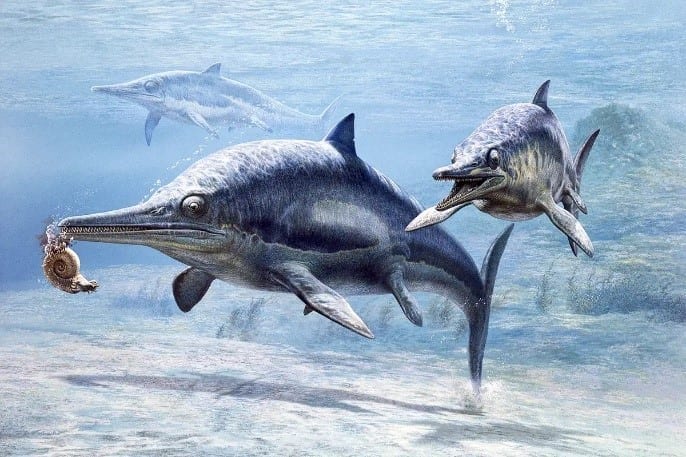 The range of dinosaur era fossils containing biological material is growing rapidly as well. Very recently, Johan Lindgren and co-workers published their analysis of a fossilised ichthyosaur (a large dolphin-like sea creature from the dinosaur period) in a remarkable state of preservation.[11] The “180 million year old” fossil, found in Germany, is in such a good state of preservation that pieces of skin are still flexible and they contain folds and ripples, as well as cells that held some of the animal’s pigmentation and traces of blubber. Researchers also claim that the remains still have vestiges of their original proteins. See images below, from their December 5, 2018 Nature publication.
The range of dinosaur era fossils containing biological material is growing rapidly as well. Very recently, Johan Lindgren and co-workers published their analysis of a fossilised ichthyosaur (a large dolphin-like sea creature from the dinosaur period) in a remarkable state of preservation.[11] The “180 million year old” fossil, found in Germany, is in such a good state of preservation that pieces of skin are still flexible and they contain folds and ripples, as well as cells that held some of the animal’s pigmentation and traces of blubber. Researchers also claim that the remains still have vestiges of their original proteins. See images below, from their December 5, 2018 Nature publication.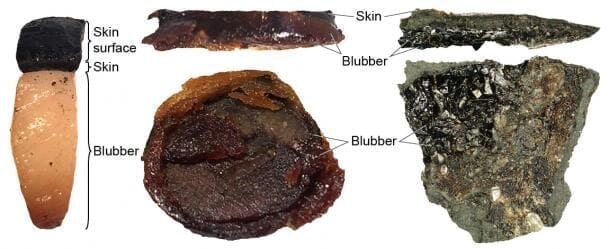
Again, very recently a group of stylophorans, thought to have been ancestors of star fish, which lived “541 million years” ago, have been found, some of which still have soft tissue.[12]
Conclusion
Deep time, which is necessary for the evolution story, is coming undone on three fronts:
- Soft tissue, which can only remain intact in our environment of oxygen, bacteria, water and temperature for only a few thousand years, is being found in an increasing number and variety of fossils.
- Carbon 14 analysis performed on eight dinosaur bones showed measurable amounts of carbon 14.[13] This isotope has a half-life of 5,730 years, so in ten half-lives, that is 57,300 years, there should be no carbon 14 left.
- Vance Nelson, in his book Untold Secrets of Planet Earth; Dire Dragons,[14] contains many photos of drawings, engravings and clay figures of dinosaurs, some as late as the sixteenth century. The book demonstrates clearly that dinosaurs co-existed with mankind.
These findings involving hard scientific evidence are demolishing the evolution story because it requires hundreds of millions of years. As well, the story claims that a group of dinosaurs evolved into birds and if dinosaurs became extinct only a few hundred or thousand years ago, they could not have changed into birds. And besides, a great variety of modern birds have been found with dinosaur fossils as shown in Carl Werner’s informative and beautifully illustrated book; Living Fossils.[15]
There is only one alternative to evolution, which is creation by a Supernatural Being, namely, the God of the Bible.
[1] C. Nielsen-Marsh, The Biochemist, June 2002, page 12. Allentoft et al, Proceedings of the Royal Society B Biological Sciences doi: 10.1098/rspb.2012.1745.
[2] M. Schweitzer and T. Staedter “The Real Jurassic Park”, Earth, June 1997, pages 55–57; Schweitzer, M. H., Wittmeyer, J. L., Horner, J. R. and Toporski, J. K., Soft-tissue vessels and cellular preservation in Tyrannosaurus rex, Science, 2005, (307), pages 1952-1955; B .Yeoman, Discover, 2006, vol. 27 No 4, pages 37–41; New Scientist, March 24, 2005.
[3] M. H. Schweitzer et al., Biomolecular characterization and protein sequences of the Campanian hardrosaur B.canadensis, Science, 324 (5927): 626-631, 1 May 2009.
[4]Geology, vol 34, p. 641; New Scientist, January 22, 2011, pages 42-45.
[5] Creation, June–August, 2007, 29 (3), page 10 citing; Biological Letters, April 22, 2007, 3 (2), 197–200; The Western Australian, February 14, 2007.
[6] New Scientist, March 7, 2009, page 14.
[7] Creation, 2008, 30 (3), page 12.
[8] Microbial Ecology, 1999, 38, pages 58–68, cited in Creation, 2008, 30 (3), page1.
[9] Nature, 2000, 407 (6,806), 897–900, cited in Creation, 2008, 30 (3), page 12.
[10] http://www.earthtouchnews.com/discoveries/discoveries/75-million-year-old-blood-cells-found-preserved-in-dinosaur-bones
[11] nature.com/articles/s41586-018-0775-x.epdf?referrer_access_token=EJNb2WAwJ99CKPoW3nXAd9RgN0jAjWel9jnR3ZoTv0P958V_0CjDuBCVEs1axEdTd49dRVZgl6BEDrR6_mQog1-S82L-C8TcDD9DT_mlNay9TwzT9sLYAnsJp3aCBS_qNTmpJPX3Wu4R5HJOMJPTT8GqpXPY9owMaiIsWycpJS5u3zbmRbppXUjH3pifF8tWHyjjEZFz3ely4_BkI4oyBw%3D%3D&tracking_referrer=www.nationalgeographic.com
[12] New Scientist, 22/29 December, 2018.
[13] Presented at the joint American, Geophysical Union and the Asia Oceania Geosciences Society, August 13-12, 2012. Creation.com/c14-dinos.
[14] Vance Nelson, Untold Secrets of Planet Earth; Dire Dragons, 2011.
[15] Carl Werner, Living Fossils Evolution: The Grand Experiment Vol 2, New Leaf Press, 2008.


3 Comments. Leave new
How can Jesus be God?!
God is immortal and did not die. But Jesus did die, and he died completely as is pointed out in your book (“A defence of the Bible.”)
I understand John 1: 1 to 4 in most versions is wrong in referring to the “word”as “he”…..William Tyndale got it right translating the Greek to be “it” instead of “he.” “It” being the Word which God spoke, not Jesus.
Jesus was human not Devine and so not of the Godhead. He was in God’s plan from the beginning and I believe Jesus was spoken into existence to arrive on earth when and as he did ie a baby to the virgin Mary.
Tks for your book a truly great effort of research and very interesting.
Cheers and God bless you and yours,
Dave Jenkin.
Thanks again for providing compelling evidence for a created youth earth.
The fossil of a 180-million-year-old ichthyosaur from the Jurassic era has been discovered and it contains evidence of blubber and skin, making the creature more similar to modern-day dolphins than previously thought.